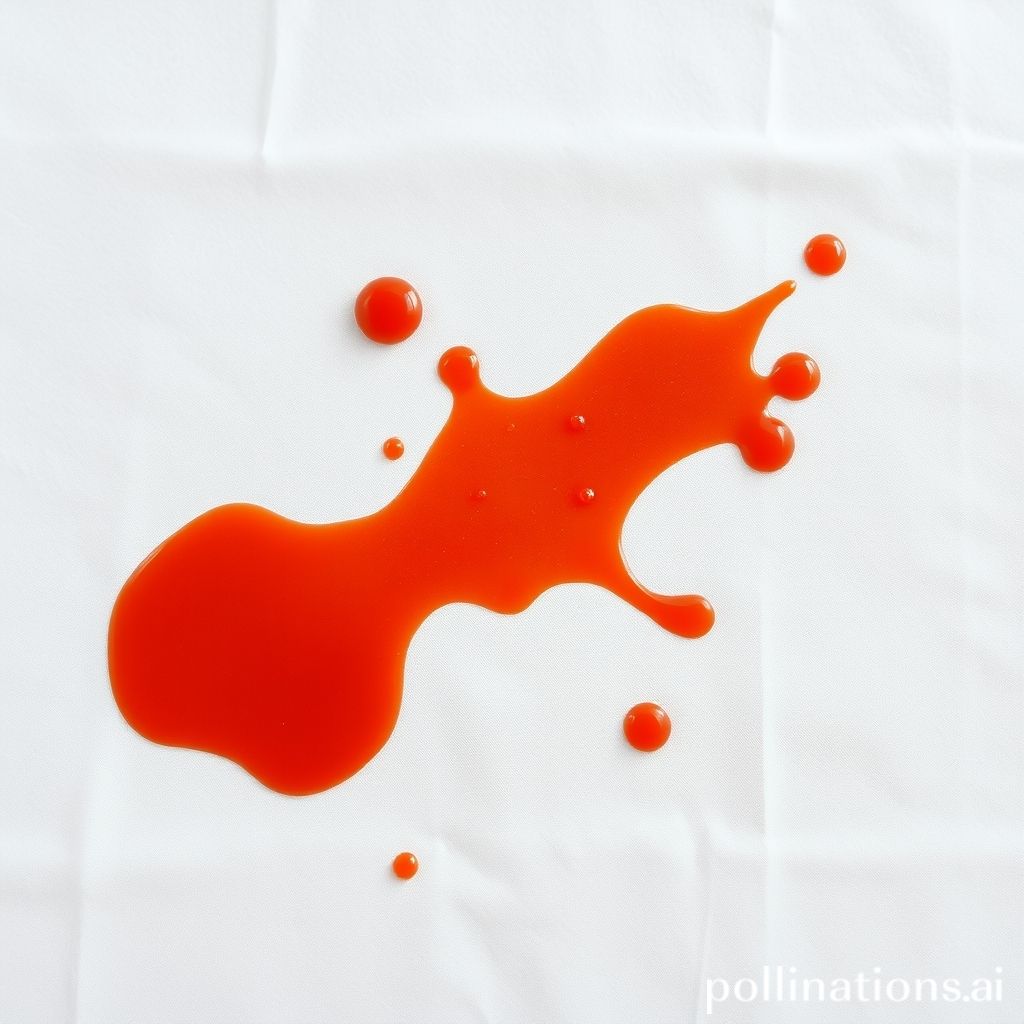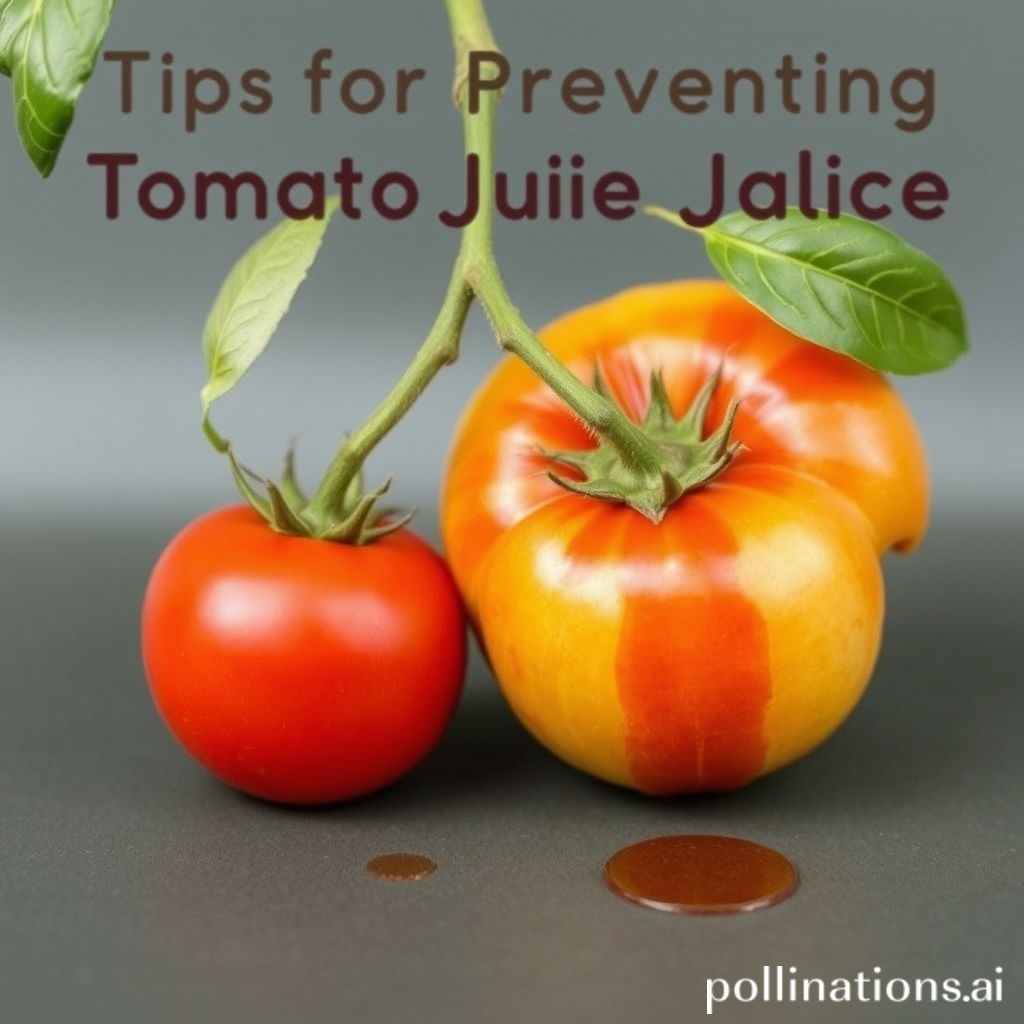Does Tomato Juice Stain?
Do you love the tangy taste of tomato juice? Whether you’re sipping it on a hot summer day or using it as a base for your favorite cocktails, there’s no denying its refreshing qualities. But have you ever wondered if tomato juice can leave behind stubborn stains?
In this article, we’ll delve into the science of tomato juice stains, uncover the surfaces it can potentially damage, and provide you with expert tips on how to prevent and remove those pesky stains. Say goodbye to tomato juice stains and keep your surfaces looking immaculate.

Table of Contents
What Causes Tomato Juice Stains?
The Composition of Tomato Juice
Tomato juice is composed of water, vitamins, minerals, sugars, and organic compounds. The high water content provides refreshment, while the vitamins and minerals offer essential nutrients. However, it is the organic compounds present in tomatoes that contribute to their staining properties.
Pigments and Acids in Tomatoes that Cause Staining
Tomatoes contain pigments called lycopene and carotenoids, which give them their red color. These pigments are responsible for the staining potential of tomato juice. When tomato juice comes into contact with fabrics or other porous surfaces, the pigments can penetrate and leave behind stubborn stains.
Tomatoes also contain natural acids, such as citric acid and malic acid. These acids contribute to the tangy taste of tomatoes and enhance their staining ability. The acidic nature of tomato juice weakens the bonds between stains and surfaces, making them more difficult to remove.
To prevent tomato juice stains, it is advisable to handle spills promptly. Blotting the stain gently with a clean cloth or paper towel can help remove excess juice before it sets. Avoid rubbing the stain vigorously, as this can spread the pigment and worsen the stain.
In conclusion, tomato juice stains are caused by the organic compounds, pigments, and acids present in tomatoes. Understanding the composition of tomato juice and taking immediate action to treat stains can help minimize their impact and preserve the appearance of fabrics and surfaces.
Expert Tip: Act quickly to prevent tomato juice stains. Blot gently, don’t rub, to remove excess juice before it sets. #StainRemovalCan Tomato Juice Stain Surfaces?
A. Staining Potential on Clothing and Fabrics
Tomato juice is notorious for staining clothing and fabrics due to its vibrant red color and pigments that can seep into the fibers. To prevent tomato juice stains on clothing, act quickly by blotting the stain gently with a clean cloth or paper towel. Avoid rubbing the stain, as it may spread and become more difficult to remove. Treat the stain with a pre-wash stain remover or a mixture of mild detergent and water before laundering as usual.
B. Potential Stains on Carpets and Upholstery
Accidental spills of tomato juice on carpets or upholstery can cause discoloration and stubborn stains due to its acidic nature. Minimize the damage by blotting the area with a clean cloth or paper towel to absorb as much liquid as possible. Avoid scrubbing, as it can push the stain deeper into the fibers. Prepare a solution of warm water and mild dish soap, then gently dab the stain with the solution using a clean cloth, working from the outer edges toward the center. Rinse the area with clean water and blot dry. If the stain persists, consider consulting a professional carpet or upholstery cleaner.
C. Staining Risks on Countertops and Other Surfaces
Tomato juice can also pose staining risks to countertops and other surfaces, especially porous ones like marble or granite. To prevent staining, wipe up any spills immediately with a damp cloth. Avoid using abrasive cleaners or scrub brushes, as they can damage the surface. Instead, opt for a mild dish soap or a specialized stone cleaner. Regularly applying a sealant to your countertop can provide an additional layer of protection against stains.
Stain Prevention Tips
| Surface | Stain Prevention Tips |
|---|---|
| Clothing and Fabrics | Act quickly, blot the stain, use pre-wash stain remover or mild detergent |
| Carpets and Upholstery | Blot the area, use warm water and mild dish soap, consult a professional if needed |
| Countertops and Other Surfaces | Wipe spills immediately, use mild cleaners, apply sealant regularly |
Tips for Preventing Tomato Juice Stains
Wearing Aprons or Protective Clothing
One effective way to prevent tomato juice stains is by wearing aprons or protective clothing while handling this vibrant red liquid. Tomato juice can easily splatter or spill, especially when cutting or squeezing tomatoes. By wearing an apron or protective clothing, you create a barrier between the juice and your clothes, minimizing the risk of stains.
Using Cutting Boards or Trays
Another useful tip to prevent tomato juice stains is to use cutting boards or trays when working with tomato juice. When cutting or squeezing tomatoes, the juice can often escape and make contact with surfaces, such as countertops or tables. By using a cutting board or tray, you can contain the spills and minimize the chances of the juice staining your surfaces.
Being Cautious When Consuming Tomato Juice Near Surfaces
When enjoying a refreshing glass of tomato juice, it’s important to be cautious and mindful of your surroundings. Tomato juice can easily spill or splash, especially when drinking from an open container. To prevent stains on surfaces, ensure that you are not near any valuable items or materials that may be susceptible to staining. Consider using a straw or drinking from a covered container to minimize the risk of spills.
To summarize, preventing tomato juice stains can be achieved by wearing aprons or protective clothing, using cutting boards or trays, and being cautious when consuming tomato juice near surfaces. By following these simple tips, you can enjoy the deliciousness of tomato juice without worrying about unsightly stains.
| Tips for Preventing Tomato Juice Stains |
|---|
| Wearing Aprons or Protective Clothing |
| Using Cutting Boards or Trays |
| Being Cautious When Consuming Tomato Juice Near Surfaces |

Removing Tomato Juice Stains from Clothing
| Information |
|---|
| Tomato juice stains can be stubborn and unsightly, but with the right techniques, you can effectively remove them from your clothing. Acting quickly and using the proper stain removal methods will help prevent the stain from setting and make the removal process easier. |
Acting quickly and blotting the stain
- 1. Grab a clean cloth or paper towel: As soon as you notice the tomato juice stain, reach for a clean cloth or paper towel to begin the stain removal process.
- 2. Gently blot the stain to remove excess tomato juice: Place the cloth or paper towel over the stain and gently press down to absorb as much of the tomato juice as possible. Avoid rubbing the stain, as it can spread the juice and make the stain worse.
Pre-treating with stain remover or laundry detergent
- 1. Apply a small amount of stain remover or laundry detergent directly to the stain: After blotting the stain, apply a small amount of stain remover or laundry detergent directly onto the affected area. Make sure to choose a stain remover or detergent that is safe for the fabric.
- 2. Gently rub the product into the stain using a soft brush or your fingers: Using a soft brush or your fingers, gently work the stain remover or detergent into the fabric. Be careful not to scrub too hard, as it can damage delicate fabrics.
Washing the clothing with cold water
- 1. Rinse the stained area with cold water to further remove the tomato juice: After pre-treating the stain, rinse the affected area with cold water. This will help to remove any remaining tomato juice and the stain removal product.
- 2. Launder the clothing as usual, following the care instructions on the garment: Finally, launder the clothing as you normally would, following the care instructions on the garment. Make sure to check the clothing after washing to ensure the stain is fully removed. If the stain persists, repeat the stain removal process or consider seeking professional help.
Removing Tomato Juice Stains from Carpets and Upholstery
1. Blotting the stain gently
To remove tomato juice stains from carpets and upholstery, act quickly. Blot the stain gently with a clean cloth or paper towel. Avoid rubbing the stain to prevent spreading. Blotting helps absorb the tomato juice before moving to the next step.
2. Using a mixture of dish soap and water for cleaning
After blotting the stain, mix mild dish soap with warm water to create a cleaning solution. Apply the solution to the stained area using a cloth or sponge. Gently blot the stain from the outer edges to the center to prevent spreading. Repeat until the stain fades.
3. Steam cleaning or professional cleaning for stubborn stains
If the tomato juice stain remains, try steam cleaning. Steam cleaning effectively removes deep-seated stains. Alternatively, consider professional cleaning for stubborn or older stains. Professional cleaners have the expertise and equipment to tackle tough tomato juice stains for thorough removal.
To remove tomato juice stains from carpets and upholstery, remember to blot gently, use a dish soap and water mixture, and try steam cleaning or professional services for stubborn stains. By following these steps, you can restore cleanliness and appearance, effectively eliminating tomato juice stains.
Conclusion
Tomato juice can stain various surfaces due to its pigments and acids. To minimize the risk of stains, it is important to take preventive measures like wearing protective clothing and using cutting boards or trays. If stains occur, acting quickly is crucial.
For clothing, pre-treating with stain remover or laundry detergent and washing with cold water can help remove tomato juice stains. For carpets and upholstery, gentle blotting and cleaning with a mixture of dish soap and water is recommended. Stubborn stains may require professional assistance or steam cleaning. Remember, prompt action is key to achieving the best results in stain removal.
Faq about Tomato Juice Stains
FAQ 1: Can tomato juice stain wooden surfaces?
Yes, tomato juice can stain wooden surfaces. The acidic nature of tomato juice can penetrate the wood and leave behind a stubborn stain. Clean up spills immediately to prevent the stain from setting in.
FAQ 2: How do I remove tomato juice stains from white clothing?
To remove tomato juice stains from white clothing, rinse the stain with cold water to dilute it. Apply a pre-treatment stain remover or liquid laundry detergent directly to the stain. Gently rub the fabric together to work the stain remover into the fibers. Finally, wash the clothing in the hottest water recommended for the fabric.
FAQ 3: Does tomato juice stain stainless steel?
Yes, tomato juice can stain stainless steel surfaces. The acidic properties of tomato juice can cause discoloration on stainless steel if left untreated. Promptly clean any spills or stains on stainless steel surfaces to prevent staining.
FAQ 4: Can tomato juice stain plastic containers?
Tomato juice can stain plastic containers, especially if they are porous or have scratches. The pigments in tomato juice can seep into the plastic, causing a difficult-to-remove stain. Avoid storing tomato juice or tomato-based products in plastic containers if possible.
FAQ 5: What if the tomato juice stain doesn’t come off after washing?
If the tomato juice stain persists after washing, try treating the stain with a stain remover or liquid laundry detergent and letting it sit for a few minutes before washing again. If the stain still doesn’t come out, you can try using a mixture of hydrogen peroxide and water to soak the stained area before washing. Alternatively, consider seeking professional help or using specialized stain removal products for stubborn stains.
